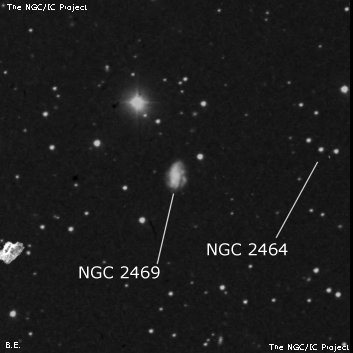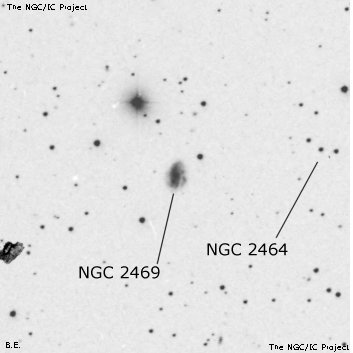NGC/IC Project Restoration Effort
(This is a very very beta version)
NGC2469


Basic Information
Location and Magnitude
Right Ascension: 7:58:3.2
Declination: +56:40:48
Constellation: LYN
Visual Magnitude: 12.7
Historic Information
Discoverer: Herschel W.
Year of discovery: 1790
Discovery aperture: 18.7
Observational
Summary description: F, vS, R, * 9 sf
Sub-type: Sb/P
Corwin's Notes
=====
NGC 2469 group. Two objects here were seen by the Herschels: NGC 2463 (JH)
and NGC 2469 (WH and JH). The identity of these two is certain since John
Herschel's positions are good. Lord Rosse saw, but did not measure them. He
has only a note: "Great many knots, reckoned 10 nearly in a line pf." So,
Herschel added eight other GC numbers for the additional objects even though
no positions were available for them. Dreyer followed Herschel's lead
explicitly with 10 NGC numbers for all the objects.
Bigourdan measured eight of the 10 objects in 1886, so Dreyer was able to
adopt Bigourdan's positions and identifications for six of the non-Herschel
objects: NGC 2458, 2461, 2462, 2464, 2465, and 2471. Bigourdan returned to
the field in 1895 and 1900, measuring three other objects, one of which he
mistook for NGC 2458, and another which became IC 2210. A third was not
included in any of Dreyer's catalogues, and did not even receive a number in
any of Bigourdan's lists of "novae." He did not observe NGC 2472 or 2473 --
the final two of Lord Rosse's 10 -- so they have only approximate positions in
the NGC.
The Palomar Sky Survey shows only seven galaxies here, one faint and small
enough, and well enough away from the others, that it may not have been seen
by Lord Rosse. It was certainly not seen by Bigourdan, who in fact saw only
four of the galaxies (his first observation of N2458, N2462, 63, and 69).
Five other of his objects are asterisms -- single stars (N2461, 65), doubles
(N2471, I2210), or a triple (N2464). The two remaining nebulae in Bigourdan's
list (his second observation of N2458 and the unnumbered "nova") are
unidentifiable, with only very faint stars near -- but not at -- his
positions.
As I mentioned above, the chances are good that Lord Rosse only saw the six
brightest of the galaxies (the others were probably stars as the rich field is
at a fairly low Galactic latitude; it is not unusual to find stars among Lord
Rosse's novae). Since Dreyer used Bigourdan's 1886 positions, four of the NGC
numbers are assigned to galaxies, and four others are taken up by asterisms.
There are thus two galaxies without NGC numbers -- and fortuitously, two NGC
numbers (N2472 and N2473) without galaxies. Since N2472 has been used by the
CGCG for one of the unnumbered galaxies, I suggest using N2473 for the other.
The only unfortunate result is that this puts N2473 -- the last of the 10
numbers -- preceding all but one of the other objects (the exception is the
very faint galaxy that Lord Rosse may not have seen): it is out of NGC order.
It's clear that these two identifications are uncertain, even though they are
logical given the facts we have.
Steve's Notes
=====
NGC 2469
24" (1/25/14): at 375x appeared moderately bright to fairly bright, fairly small, elongated 4:3 NNW-SSE, 36"x28", slightly brighter core, appears mottled. Located 2.3' SSW of a mag 9.5 star. 5th of 6 galaxies in a 25' E-W string.
17.5" (1/19/91): fairly faint, small, oval 3:2 NNW-SSE. A mag 14.5 star is off the NW end 0.8' from center. Third of three on a line with NGC 2472 6' E.



